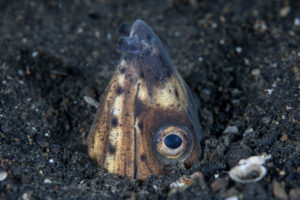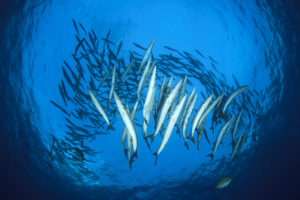If you’ve seen the first installment of our basic Fish ID series, you know that over 20,000 species of fish populate the world’s waters. Most new (and experienced) divers are keenly interested in the aquatic life around them, but becoming an expert takes years of study and experience. However, as a starting point for basic fish ID, let’s look at five more common fish families.
Sharks
Sharks have inhabited the planet’s oceans for approximately 400 million years. For scale, most evolutionary biologists state that humans have only been on the planet in our current form for around 200,000 years. Sharks’ size, power and predatory nature fascinates divers and non-divers alike. Here are a few tidbits about sharks that you may not know.
* Sharks are cartilaginous fish, which means that they have no bones. Their bodies are made of super-strong, flexible and lightweight materials. They also lack a swim-bladder, and will sink if they don’t continuously move forward through the water.
* Unlike bony fish, sharks don’t have scales. Their skin is covered with small miniature teeth called dermal denticles, complete with root and enamel.
* Sharks have independent upper and lower jaws that allow them to bite, clamp and pull their prey. Each carnivorous species continuously loses and replaces teeth. Some sharks may use and lose up to 30,000 teeth in their lifetime.
* Many sharks have efficient livers that act as storage banks for essential oils, which they use for fuel. Some sharks can go weeks or months without eating.
* Finally, sharks have finely-honed senses. They have superb sight, hearing, smell and other senses such as their “lateral line,” which lets them pick up vibrations. Their “Ampullae of Lorenzini” are special sensory organs that pick up a prey animal’s electrical charge in the water.
There are over 400 shark species, each with a distinctive silhouette and feeding habits. Sizes range from small — the pale catshark is only around nine inches long — to whale and basking sharks, which can grow to 40 feet long.
Sharks to look for: whitetip, blacktip, hammerhead, Caribbean reef, nurse, and whale sharks

Eels
Although they look like snakes, eels are in fact any fish that belongs to the order Anguilliformes. Long and slender, often without pectoral fins, eels vary in size from just a few inches long to giant morays, which can grow 6 to 10 feet (2-3 m) long.
There are over 800 eel species in the world’s oceans, lakes and rivers. Eels have adapted to both salt and fresh water, tropical and more temperate or colder waters. They vary between camouflaged and colorful, depending on species and environment.

Eels spend most of the day lying dormant in the shallows, usually buried in the sand with heads protruding or tucked into a hole in the reef. As nocturnal hunters, divers are unlikely to see them swimming in the open sea during the day.
When swimming over a sandy patch, look for garden eels. Often, you’ll see an entire field of the creatures, their white heads and black-spotted bodies poking from the sand. Ribbon eels are rarer but equally as fascinating. You’ll also usually see them poking out from the sand on the seabed in tropical waters. These long, thin eels have extended anterior nostrils and their color indicates whether they are juvenile, male (predominantly black/blue) or female (yellow).
As their name suggests, giant morays can grow to an intimidating 9 feet (3 m) long and weigh up to 66 pounds (30 kg). Brown with black spots, the giant moray has immensely powerful jaws with sharp teeth. Divers usually see this eel during the day, resting with its mouth open and being cleaned by shrimp and wrasse.
Eels to look for: Giant moray, garden eel, Ribbon eel, honeycomb moray
Rays
Stingrays, skates, electric rays and sawfish form part of a family known as Batoidea. Rays are evolutionarily closely related to sharks. Rays share sharks’ cartilaginous skeleton structure, but with flattened bodies and super-sized pectoral fins that, in some cases, cover their whole flank from head to tail. The Batiodea family includes over 500 species within approximately 13 sub-families.
Sawfish are easy to distinguish, with their smaller pectoral fins and long snouts shaped, eponymously, like a saw.
Electric rays are rounder and have electric organs in their sides, which create an electric field. They may use the electrical discharge for navigation, communication and, when necessary, to shock predators or prey.
Closely related in appearance are stingrays and skates, though recent studies show that they evolved independently of each other. Skates have flat, powerful teeth on their underside. Usually carnivorous bottom-dwellers, they use these teeth to crush and eat their prey.
The stingray family includes diver favorites such as whiptail, blue-spotted, thornback, eagle, butterfly and manta rays.
Rays to look for: eagle ray, blue-spotted ray, manta Ray, marble ray
 Lionfish
Lionfish
Beautiful but poisonous, lionfish (Pterois) are the less-dangerous cousins of scorpionfish and stonefish. In contrast to the highly camouflaged and venomous scorpionfish and stonefish, which lie in wait to swallow their prey, lionfish are often colorful, easier to identify, and actively ambush their prey. Sometimes lionfish are known locally as zebrafish or butterfly cod.
Lionfish live between five to 15 years and are approximately 2 to 18 inches long (5 to 45 cm). Their colorful, ornate bodies are often red/brown and white striped and lined with venous spines along their backs for protection from predators. Lionfish are skilled hunters that feed on small fish and mollusks. They can precisely control their swim bladders and can hover motionless in the water column. The venom their spines, while not immediately deadly to humans, can cause anaphylaxis and requires immediate treatment. Most lionfish are very easy to spot and often make good photography subjects. An invasive species in the Caribbean, many nations are trying to cull them from the waters.
Lionfish to look for: Pacific lionfish, spotfin lionfish

Barracuda
Barracuda are from the family Sphyraenidae. Known for their sleek, streamlined bodies, razor-sharp teeth and prominent under-bite, these distinctive looking creatures have the aggressive appearance of a stretched piranha with silvery, chevron-flanked bodies. A great barracuda can grow to nearly three feet (1 m) long.
With twin spiny dorsal fins and a large swim bladder, you’ll sometimes see barracuda hovering, nose-on to the current, seemingly motionless in the water.

Colors vary among the 28-known species, but most common in tropical waters are silver barracuda such as the great barracuda, pickhandle barracuda, chevron or blacktail, and yellowtail barracuda.
These fish are skilled hunters and can launch at prey with bursts of speed of up to 25 mph (40 kmh). Attacks on humans are exceedingly rare and often due to mistaken identity, the barracuda convinced that a shiny ring, necklace or earring is prey. Divers will sometimes see barracuda schooling in groups of hundreds.
Barracuda to look for: great barracuda, pickhandle, blacktail, yellowtail








